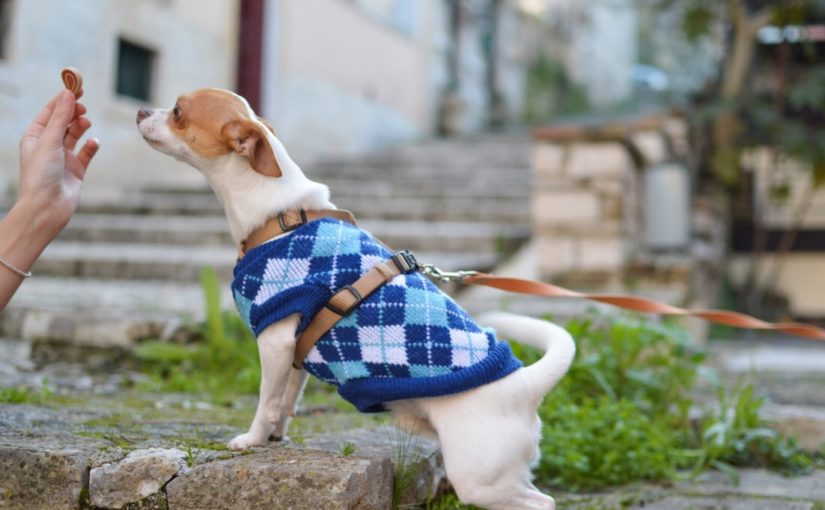No pet owner wants their pup to be unhealthy and overweight, do they? Chihuahua’s are full of life and plenty of personality, so if you own one and they are looking slightly podgy and you are concerned about their well-being, then it may be time to take some action to make sure they are as happy and healthy as possible.
We’ve broken this down into three sections for you so that you can take away as much valuable information as possible. Don’t panic if your pooch is looking a bit larger than normal because it can be rectified in most cases.
Obese dogs are at risk of additional health-related problems and therefore, the quicker you address things the better. Below you will see how to diagnose the issue, then read some tips on prevention in future before learning about treatment for overweight Chihuahuas.
Diagnosis
When you run your hands over your dog’s ribs, you should be able to feel them. If you can’t, then it might be the case that they are being over-fed and/or under-exercised. What’s more, we often find that overweight dogs are allowed access to too many treats; remember, they should only be 10% of a Chihuahua’s diet.
Chihuahuas should display a nice definition to their body. Things to note include a chest and – as we mentioned – a rib cage, which should appear round and slightly stick out. Following down the line to the rear, their body should slim down to a waist where you meet the hips. If you can see/feel that your Chihuahua doesn’t have a waist, then this is a sign that they are overweight.
Additionally, if you have observed that your Chihuahua is having difficulty scratching or licking areas of themselves then this can be a another characteristic of being overweight.
For any dog, carrying excess weight is unhealthy and potentially harmful. Chihuahua’s, in particular, are more susceptible to issues that surround being overweight.
For instance:
- Excess fat puts additional strain and stress on their body. It can lead to problems with their knees and hips under the extra load.
- Bones can become damaged along with ligaments and joints.
- Diabetes is a renowned issue associated with excess weight.
- There’s a bigger risk for heart disease.
Prevention
Dog owners love to treat their pets, but this has downsides, as we touched on. You must get them eating the correct amount of food to avoid health-related setbacks.
Adult Chihuahuas are roughly only 2-6 lbs, which means that they only really require around 70-270 calories a day. Make sure you carefully read the instructions on the food that they eat and weigh it correctly to avoid overeating.
It’s absolutely essential that your pooch gets the exercise it needs to stay fit and on weight. Chihuahuas of all ages need to be walked 1 to 2 times a day for at least 20 minutes.
When you let your dog out to do its business, don’t instantly call them back in. Let them roam around in the garden for some time and stretch their legs too.
Points to remember:
· Strict diet
· Treats are only 10% of food
· Regular exercise
Treatment
Snacks and Food: Just because your dog is overweight they might not need to be fed less; it could be a case of changing the food included in their diet.
Taking out the store-bought snacks for foods such as apple slices or raw baby carrots is a start.
Think about putting some string beans and baby peas in the main meals. This is a super way to give them the same amount of food while also being a great way to offer the same amount of food but with higher quality and fewer calories.
Exercise: Aim to gradually increase the level of exercise you four-legged friend is doing. Take it slowly, only increasing the amount by 10% each week. If your pet is struggling, don’t force them into longer walks, although you should be able to tell the difference between them struggling and just being lazy!
Remember that you shouldn’t have massive expectations of your dog if they have been largely sedentary for some time. They aren’t going to be capable of instantly trotting out for two decent walks per day, and it can lead to injuries and strain on the body if they’re suddenly made to do so.
The final goal is to reach a constant two walks a day that last for between 20 minutes and half an hour at a moderate pace. Keep it brisk, but don’t be so pacey that you are dragging them behind.
Keep an ear out for your pup’s breathing as they shouldn’t be panting excessively.
If your dog is finding it hard to get out for walks due to weight/health issues, you can get them being more active indoors too. For example, you can play a game of hide and seek and teach them to look for a toy/healthy snack that you’ve hidden.
Playtime is important and most dogs revel in the interaction that it brings. They’ll feel better mentally and physically, just as we do when we are more active.
Lastly, just be mindful that you are keeping your expectations at a reasonable level and if you feel your Chihuahua is at risk regarding how fat they are, get in touch with your veterinarian.
